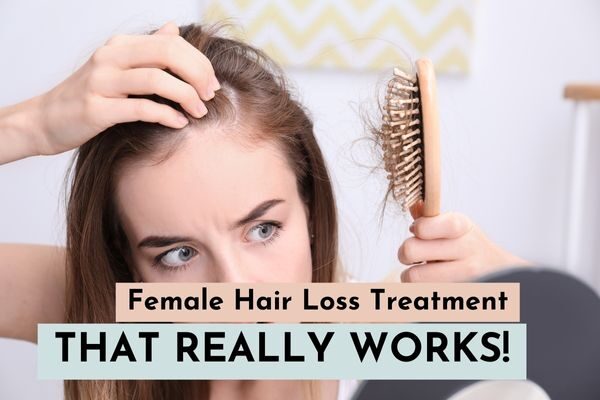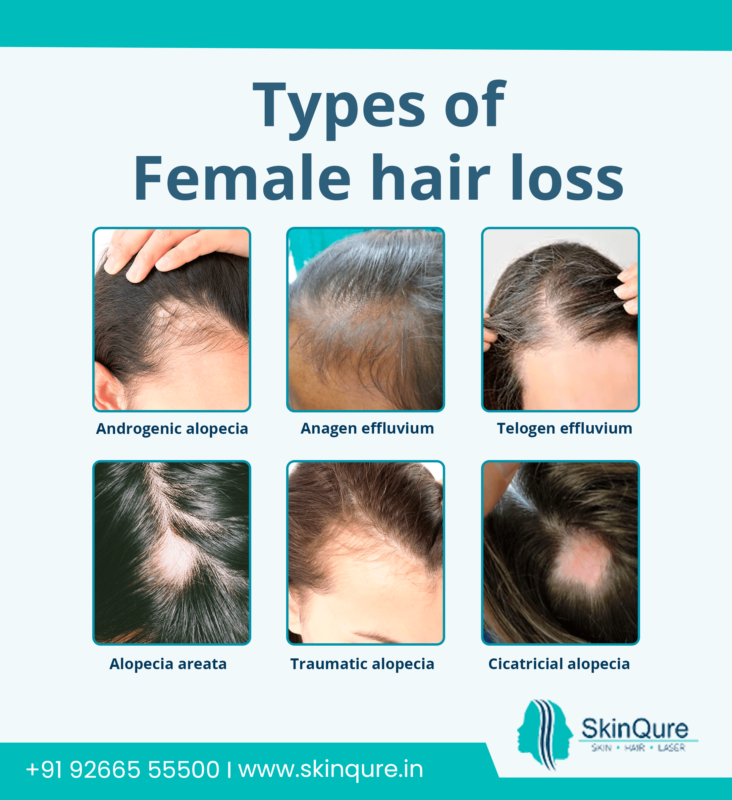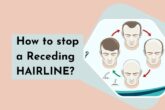
Losing your hair may have a significant impact on your psychological well-being. Women are not immune to hair loss, even though it is more common in males. According to research, 40 percent of women over the age of 70 suffer from hair loss. And around 12 % of women between the ages of 20 and 29 suffer from some form of hair loss.
Alopecia, or hair loss, is a difficult condition to live with, especially for women, because it is socially stigmatized. Women with severe or borderline alopecia may struggle with self-confidence and self-esteem. If treatment for female hair loss begins early, it may be beneficial in the long run.
Patients should visit an experienced dermatologist, such as Dr. Jangid at SkinQure, to learn more about various programs for female hair loss treatment in south delhi.
Table of Contents
Feel free to skip ahead if one topic catches your eye
- Female Hair Growth Cycle
- What are the Main Causes of Hair Loss in Females?
- Symptoms and Diagnosis
- What is the best treatment for female hair loss in Delhi?
- What to expect after the Hair Loss Treatment?
Female Hair Growth Cycle
The hair follicle is a type of anatomical structure found in the dermis of the scalp. Each hair has its follicle, from where a hair grows. The protein keratin, which is an insoluble protein, is the most important component of the hair. Hair undergoes a growth cycle and it’s crucial to understand the growth cycle to figure out what’s causing your hair loss. The duration of a person’s hair cycle determines the maximum length of hair that may be achieved.
The different stages of the hair growth cycle are as follows:
- Anagen (growth phase): This is the most active phase of hair growth, lasting 2 to 7 years. Hair grows at a higher pace in the first few years of life.
- Catagen (transitional period): It is a stage in which the hair follicles atrophy and detach from the scalp’s base. In this phase, the active hair follicles are transitioned to resting hair follicles. This can last up to 3 weeks
- Telogen (resting phase): The separated follicles stay dormant throughout this time, and new follicles begin to develop. Under normal circumstances, 10% to 15% of hair is in this stage. This phase can last up to 3 to 4 months.
- Exogen (Shedding Period): The old hair is shed from the scalp by combing or washing.
Normally, losing around 100-150 strands of hair is considered normal. These are the telogen hair being shredded. In alopecia, the hair loss exceeds the average range. The hair growth cycle maintains a balance where the amount of hair shed is proportional to the amount of new growth, but a variety of factors can disrupt the hair growth cycle, resulting in temporary or permanent alopecia.
There are different types of Alopecia:
- Androgenic alopecia: Androgens/ male hormones play a crucial role in hair loss in both males and females. Also referred to as pattern baldness, this condition is genetic and can be inherited from the parents. The androgen receptors at the front and scalp are sensitive to androgens and thus leads to a miniaturization of hair follicles in those areas.
- Anagen effluvium: It is induced by medicines that poison the developing hair follicles. It is most commonly observed after chemotherapy. The administration of radiation, drugs, and various chemical treatments impair the anagen phase.
- Telogen effluvium occurs when a large number of hair follicles enter the telogen phase, resulting in significant hair loss. Factors like pregnancy, shock, and illness can disrupt the normal hair cycle and can cause premature cessation of anaphase.
- Alopecia areata: hair loss is seen in the form of random bald patches around the head.
- Traumatic alopecia: caused by constant stress and friction produced by numerous hairstyling procedures and harsh chemicals.
- Cicatricial alopecia: a group of disorders that results in permanent hair loss due to inflammation. The hair follicle is destroyed and is replaced with scar tissue.
- Other types of alopecia include: chemotherapy-induced alopecia, stress-induced alopecia, syphilitic alopecia, and trichotillomania (self pulling the hair)
Multiple factors can cause hair loss in females. We shall see those in the next section.
What are the Main Causes of Hair Loss in Females?
Hair loss in women is caused by a variety of factors, ranging from environmental variables like pollution and stress to hormonal changes and genetic factors. Although hair loss can affect women of any age, it is most common among women:
- About to reach menopause
- Just delivered a baby
- Underwent chemotherapy and intensive medications
- Old women
- who frequently wear their hair in tight fashions and use a lot of chemicals.
Hair loss is due to factors like age, medication, and genetics, immunological and physiological factors, some of which include:
- Genetic factors play a primary role in inducing alopecia in females. Female patterned baldness and hair thinning can be caused by the baldness gene being passed down through the generations.
- Immunological factors play a huge role in the onset of alopecia: Thyroid, diabetes, lupus, and myasthenia gravis are examples of autoimmune diseases that create an inflammatory response in the body, resulting in hair loss in women.
- Women lose hair for a variety of reasons, one of which is menopause. Female hormones such as estrogen and progesterone begin to decline after menopause. Hair loss in women is a possibility as a result of menopause.
- Hormonal imbalance is another major reason for hair loss in females, and it also plays a role in causing alopecia. Hair loss can be triggered by conditions such as PCOD that cause elevated concentrations of androgens in females. Increased androgen levels can cause female pattern baldness since androgen serves a significant role in Androgenic alopecia.
- Emotional stress and pollution have a detrimental impact on the growth of hair follicles. Stress can trigger neurological changes in the brain, which reduce blood supply to the hair follicles and contribute to alopecia.
- Postpartum hair loss is a frequent occurrence for women following pregnancy.
- Chemotherapy and radiation cause baldness, which is the most significant side effect. Chemotherapy causes hair follicles to break because it alters the anagen phase.
Symptoms and Diagnosis
Alopecia is characterized by several common symptoms. You should see an experienced dermatologist, like Dr. Jangid at SkinQure, who can assess your situation and provide assistance with the best hair loss treatment for females.
There are subtle signs that can indicate the onset of alopecia:
- Widening of the hair part: more scalp is visible when you part your hair.
- Losing more than 150 to 200 hairs. It is typical to lose roughly 200 hairs per day, but if you are losing more than this, you should consult a doctor.
- When the scalp is visible and the hair starts thinning.
- If you have a family history of alopecia and are concerned about hair loss, then the dermatologist can assist you early on.
- Recent events like pregnancy, chemotherapy, illness, and stress.
The dermatologist uses The Ludwig classification for analyzing the female hair loss patterns.
- Type 1: minor thinning that can be disguised with hair styling.
- Type 2: There is a noticeable decrease in volume and a widening of the central part.
- Type 3: scattered thinning and the appearance of the scalp.
If you notice any of the symptoms and are bothered, then visiting a qualified dermatologist should be the first thing you should do.
The doctor can make a diagnosis based on your symptoms. The diagnosis can be done by:
- Hair pluck test
- Biopsy of the scalp tissue to identify any ongoing infection
- Daily hair count and Hair pull test.
- Trichoscopy: it is a procedure in which the scalp is examined under a microscope.
- Discussing the detailed medical history of the patient.
- A blood test is performed to screen for hormonal abnormalities in women.
A good dermatologist will figure out what’s causing your hair loss and provide the best female hair loss treatment in South delhi that’s tailored to your unique needs.
Because alopecia can be caused by a variety of factors, it’s vital to get the right diagnosis and figure out what’s causing the hair loss. A qualified dermatologist will examine and evaluate the medical history before coming up with a holistic solution to the problem.
What is the best treatment for female hair loss in Delhi?
The treatment for hair loss comes next after the accurate diagnosis. In Delhi, there are a number of female hair loss treatments available in delhi. Oral medicine, laser treatments, topical solutions, and hair transplants are among the few.
- Minoxidil is a medication that has been approved by the FDA. It is available as a topical solution in concentrations of 2% and 5%. Minoxidil works by accelerating the hair cycle’s anagen phase. The treatment takes 4 to 6 months to produce results and should be continued for longer periods. It is one of the best hair loss treatments for females.
- Ketoconazole: It contains anti-inflammatory qualities and is particularly beneficial in female hair loss treatment. It has an antiandrogenic action, lowering testosterone levels.
- Cyproterone Acetate: This is used in females with PCOD and increased levels of male hormones. It works by blocking the action of male hormones in the female body.
- Platelet-rich plasma– Platelet-rich plasma is activated human plasma containing concentrated platelets and growth factors. PRP encourages hair growth. It is one of the best female hair loss treatments.
- Light treatment: it’s a new technique in the treatment of alopecia that has been approved by the FDA. It entails the use of low-level light therapy, where a laser device with a wavelength of 650 to 900 nm is used. The studies have revealed a steady increase in hair growth after the treatment.
- Iron supplements: One of the primary reasons for hair loss in women is iron deficiency. Hair loss caused by an iron deficiency can be treated with iron supplements.
- Hormone therapy is administered in females with a hormonal imbalance.
- Supplements: Hair loss can be caused by a lack of vital nutrients such as Vitamin D, biotin, zinc, and amino acids. To normalize the pace of hair growth, multivitamins and oral supplements are provided.
- Lifestyle changes: As stated earlier, stress can cause alopecia. To reduce stress, dermatologists recommend making lifestyle changes like exercising regularly, eating a well-balanced diet, and practicing meditation.
- If hair loss in women is caused by tension and friction, limiting the use of hair styling treatments and harsh chemicals may be useful in addressing hair loss.
- Hair transplant surgery: it is recommended in the later stages where the hair loss is stabilized. It’s a surgical procedure that involves the relocation of hair from the back of the head to the bald area. With the advancement of technology, surgery is becoming less invasive and producing a more natural-looking result.
The entire and average cost of female hair loss treatment in delhi is subjective and can only be evaluated after a good diagnosis. The dermatologist will customize the treatment based on the stage and severity of your condition.
What to expect after Hair Loss Treatment?
Hair loss treatments are lengthy procedures that necessitate a great deal of patience. It may take 4 to 6 months after the hair loss treatment for obvious results to appear. The time it takes to recuperate varies depending on the treatment used.
The recovery period for non-invasive and non-surgical treatment is rapid, with few to no side effects.
After 4 to 6 months, the drugs and topical solutions begin to show visible results, and they must be administered for a prolonged period to see constant results.
Hair transplant treatment takes a little longer to recover from because it is a surgical procedure:
- The donor and recipient sites on the scalp will be extremely sensitive in the first week after surgery. To speed up your recuperation, you must take complete rest.
- Tiny crusts or swelling may emerge, but these are usual post-surgery symptoms that should go away if the prescribed medication is taken. After the end of the first week, you can return to your daily schedule slowly but stay away from strenuous physical exercises for a while.
- In the second to fourth week after surgery, the crusts that formed initially will begin to peel off. On the recipient site, hair begins to grow.
- A significant thickness can be noticed after 4 to 6 months, and at the end of a year, it will be at 80-90 percent.
We at Skinqure believe that treatment does not end with surgery, thus we will accompany you throughout your hair loss treatment journey and assist you at every stage.
Take Away
Providing the best hair loss treatment for females in South delhi necessitates accurate diagnosis, tailored remedies, and ongoing care and maintenance—and we at Skinqure are here to help you with all of these things. Hair regrowth is a lengthy process that demands a great deal of patience. Dr. Jangid is a hair restoration pioneer at Skinqure and has assisted over 800 patients with unrivaled results. SkinQure is the leading hair clinic in Delhi NCR, with state-of-the-art facilities and technologies and a holistic and patient-centric approach.


